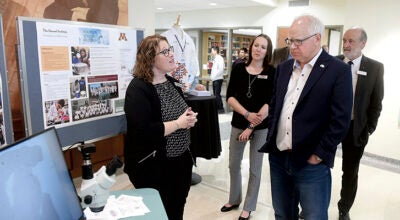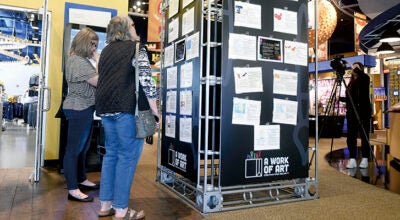Making a difference
Published 12:50 pm Saturday, March 13, 2010
Each time he squeezed solution from a pipet into a test tube, Todd Schuster flicked the bottom of the tube twice to mix cells in the liquid.
While lab leaders and researchers at the Hormel Institute write the articles and often receive the recognition, Schuster, a senior lab technician, plays an integral role behind the scenes.
Schuster performs tests and manages shared instruments at the Hormel Institute. The tests come to Schuster through requests from the lab leaders and researchers, typically through appointments.
One test Schuster frequently does is a cell cycle analysis, which he described as a common way to study how treatments affect cells and cell death.
The cells are often cancerous, and the test is to see how the cells react to varying forms of treatments.
Lab leaders and researchers prepare the tests and often prepare the cells, and then Schuster performs the tests because he is trained to use the equipment.
I give them the results,” he said. “They have to interpret them. I help them a little bit with that.”
Schuster will prepare a report, and he’ll then send it back to the lab leader.
He has a unique position because he interacts with researchers on different projects, which means cooperation is an important part of the process.
The equipment takes time and experience to learn how to operate, and Schuster said it’s important to have one person who uses and maintains the equipment.
Schuster spends much of his time preparing test samples as he stands at a counter that’s lined with test tubes, bottles of solution and test racks. However, Schuster rarely sits still in his lab, as he moves around his office from the counter to the test instruments.
The steady motors of the test instruments hum in the office, which appears narrow because a FACs cell sorter — about the size of a fax machine — rests against the east wall. A centrifuge unit and a FACs calibur flow cytometer line the west wall.
Cell cycle analysis
Schuster receives cell samples in culture dishes in order to harvest them and prepare them for analysis. He gets the samples from researchers after they’ve prepared them. Some samples are treated; others are left blank as a control.
Typically, he prepares samples the day before a test and stores them in a freezer overnight.
Before he can test the cells, he has to transfer them to test tubes and he adds solutions to the samples to prepare them for staining.
Schuster puts samples into a centrifuge, which spins samples at a high speed to compact the cells at the bottom of the tube so excess liquid can be removed.
A dye is then mixed to coat the cells, which allows Schuster to estimate cell death and assess the DNA content of the cells.
Then, the samples are placed in a dark drawer for at least a half hour for the cells and the dye to bind.
The test tracks how cells react to different levels of treatments. Schuster recently cycled about 20 samples through the FACs calibur flow cytometer. As the machine analyzed each sample, the results would show up on a computer screen in graphs.
By the time he went through about half of the samples, Schuster could tell some cells were more resistant to cell death after treatment; however, he said it’s up to the lab researchers to write articles about the findings.
With about 20 samples, Schuster estimated it takes about four hours total for such a test — an hour and a half to prep the samples and then two and a half hours for the testing.
Organization is important, so he won’t lose track of what he does, which is important as he said it’s easy to lose track as he multitasks and as people stop by to schedule a test.
Between switching samples on the cytometer, Schuster prepared the FACs cell sorter for an experiment the next day. After each experiment, he needs to purge the system to clean out the materials from the previous day.
Institute
The halls of the Hormel Institute are quiet with an occasional researcher passing through them.
“For the most part, they’re pretty serious about their research and that’s mostly what they’re trying to do is get the results and get their research published,” Schuster said.
At the same time, Schuster said workers at the Hormel Institute like to have fun. He said they had a ping-pong tournament a few weeks ago.
Schuster’s office lab window looks out at a volleyball court on the north lawn of the Hormel Institute. Schuster said people often play volleyball over the lunch hour and eat lunch there outside during the summer.
Even while Schuster’s office is typically quiet, he said he’ll play often play music during the day. One of his favorite bands is R.E.M., and he also likes to listen to Ryan Adams, The Cardinals and Lucinda Williams.
Schuster has worked at the Hormel Institute for about five years, and he previously worked in an analytical feed lab near New Ulm.
Schuster farmed for about 10 years before deciding to go back to school in the early ’90s to earn a bachelor of science degree in biology from Mankato State University — now Minnesota State University, Mankato.
Schuster decided to come to the Hormel Institute partially because the facility was growing — which offered stability — and because he thought working in cancer research would be an interesting field. The Hormel Institute is also a shorter commute to his home in Wells, as opposed to the drive to New Ulm.
“With what I do, I couldn’t work any closer to home,” he said.
Schuster’s wife, Ann, is president of People’s State Bank of Wells. The couple has two children: Lauren, 20, and John, 13.
Since he started, Schuster said the Hormel Institute has added a lot of new equipment, and there are more requests as there are more lab leaders.
Schuster trains new researchers on how to use certain equipment. He said he enjoys meeting the researchers, especially since many grew up in other countries.
“You’re definitely not doing the same thing everyday,” he said.
“There’s always something new and different coming up,” he said.
In fact, Schuster often wears multiple caps at a time. Since many tests require preparation, Schuster often preps tests for the following day, and he’ll also find time to repair equipment that malfunctions.
“Since we expanded, the maintenance of the instruments has gotten to be more time consuming,” he said.
Schuster typically works 8 a.m. to 5 p.m., but he said he’ll flex his schedule if he has to come in early or work later for a test.
Schuster tries to keep up on research published from the institute. But since he works on so many different projects, he isn’t always able to follow the results of the studies he contributes to.
However, Schuster said it’s nice to work at a facility that’s growing.
“It’s nice to be involved with an organization that’s growing and continuing to look to grow,” Schuster said. “It’s nice to have that stability.”





